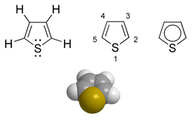User:Wickey-nl/reso
Mechanism
[edit]Electrons that in different contributing structures are shared by different atoms (different bondings) can be delocalized in several ways:
- Between single and multiple (e.g. double) bonds, as in conjugated systems
Delocalized electrons involved in resonance flow between intramolecular atoms. It occurs in conjugated systems and in zwitterions.
Electrons can flow between:
- double bonds and adjacent single bonds, as in
p-orbitals
http://www.ncbi.nlm.nih.gov/pmc/articles/PMC2668524/
zwitterion/carbene resonance image
http://pubs.acs.org/doi/abs/10.1021/ic034620n
tautomeric Cd(II) isoindoline zwitterion coordination compound
Contributing structures may be molecules or ions.

Occurrence
[edit]Strong acids, Aromaticity
---
Bond lengths
[edit]
Comparing the two contributing structures of benzene, all single and double bonds are exchanged. Bond lengths can be measured, for example with X-ray diffraction. The normal length of a C-C single bond is average 154 pm. That of a C=C double bond 133 pm and of a C≡C triple bond 120 pm. In both structures the carbon-carbon bonds should be alternating 154 and 133 pm. Instead, all carbon-carbon bonds are found to be about 139 pm, a bond length somewhere between single and double bond. This phenomenon of change of bond length is typical for all compounds in which bonds have a different bond order in different contributing structures.
Resonance in quantum mechanics
[edit]Wavefunctions
[edit] |

|
| Two representations of the resonance hybrid of benzene | |
In quantum mechanics, each contributing structure (which is a Lewis structure) is described by a certain wave function. Resonance means that the wavefunction of the compound is represented by 'mixing' the wavefunctions of the contributing structures.[1] The linear combination of the wavefunctions of all contributing structures results in the wave function of the real structure, the resonance hybrid. Characteristic for resonance hybrids, however, is that the total amount of energy present in the compound is lower than it actually could be expected. The difference in energy between the resonance hybrid and the contributing structure with the lowest energy is called the resonance energy. [1] Because this makes the resonance hybrid more stable than each of the contributing structures, it is said to be stabilized by resonance or resonance stabilised.
---
Origine: Linus Pauling The nature of the chemical bond. 1939, p.12
gallery
[edit]-
Phenol tautomers
-
Sulfate-resonance-2D.png
-
ALLYL radical resonance.png
-
Allylic resonace.png
-
Forme correcte.JPG
-
NO2-Schema-Lewis.png
-
Nitrogen-dioxide-resonance-2D.png
-
Stickstoffdioxid.svg
-
Nitrit-Ion2.svg
-
carboxylic acids
-
Ozone-resonance.png
-
Thiocyanate-resonance-2D.png
-
Carbon-monoxide-resonance-2D.png
-
Ozon.svg
-
Diethyl malonate resonance.svg
-
Nitrate-ion-resonance-2D.png
-
Naphthalene resonance.PNG
-
Carbonate-ion-delocalised
-
Glycine-zwitterion-resonance
-
Glycine-zwitterion
-
Thiophen.svg
-
Nitric oxide.svg






| 1 | − − − − |
| 2 | − − − − |
| 1 | −=−=−=−= |
| 2 | =−=−=−=− |
| ≡≡≡≡≡≡≡≡ |


In chemistry, resonance or mesomerism [2] is the appearance of delocalized electrons within a compound, giving a structure that cannot be expressed by one single Lewis formula. A molecule with such delocalized electrons is represented by several contributing structures [3] (also called resonance structures or canonical forms). Each contributing structure is reflected by a Lewis structure with a single, double or triple covalent bond between every pair of adjacent atoms within the molecule[4]. Contributing structures are theoretical possibilities that do not exist in reality, but are used to predict the real molecular structure, which is an intermediate between the canonical forms. This intermediate form is called resonance hybrid.
Resonance is a key component of valence bond theory, which uses the concept of contributing structures in the mathematical description of a molecule.
Resonance is distinguished from tautomerism, which involves formation and rupture of covalent bonds and thus implies alternating isomers.
Characteristics of resonance
[edit]
Compounds with a resonance structure, also called mesomerism, have the following basic characteristics:
- They can be represented by several correct Lewis formula, called "contributing structures", "resonance structures" or "canonical forms". Each Lewis formula must have the same number of electrons (and thus the same total charge) as well as the same number of unpaired electrons, if any.
- The contributing structures are not isomers. When transforming from one Lewis structure into another one, no sigma bonds are broken. Only pi bonds differ.
- If the bond lengths are measured, for example with NMR spectroscopy, no single and multiple bonds can be distinct. All bonds appear to have the same bond length, somewhere between single bond and multiple bond length.
- The real structure has a lower total of energy than each of the contributing structures would have. This means that it is more stable than each separate contributing structure would be.
Bond lengths can be measured for example with NMR spectroscopy. Or from X-ray crystallographic data, by analysing X-ray diffraction patterns : http://www.bbc.co.uk/dna/h2g2/A791246.
http://www.springerlink.com/content/p34078076p230378/ http://www.springerlink.com/content/p34078076p230378/fulltext.pdf?page=1
Use of contributing structures
[edit]In Lewis formula, covalent bonds are represented in accordance with the valence bond theory. Every single covalent bond is made by two valence electrons, localized between the two bonded atoms. Every double bond has additionally two localized π electrons, triple bonds have four additional π electrons between the bonded atoms.
In compounds that have a mixture of one or more single and multiple bonds, often the exact position of the respective bonds in the Lewis formula cannot be indicated. The π electrons appear to be delocalized and the multiple bonds could be on different positions. In those cases the compound cannot be represented by one single Lewis formula. To solve this problem, in valence bond theory the concept of resonance is used and the compound is represented by several contributing structures, each of which showing a possible distribution of single and multiple bonds.
None of the contributing structures are considered to represent the real structure since the assumed single and multiple bonds, if measured, in all cases appear to have the same length. The real structure is an intermediate form which is called the "resonance hybrid".
The molecular orbital theory already includes the concept of delocalized electrons and therefore has no need of the concept of resonance.
Contributing structures may be molecules or ions. In diagrams, contributing structures of a compound are typically separated by double-headed arrows (![]() ). The arrow should not to be confused with the right and left pointing equilibrium arrow (
). The arrow should not to be confused with the right and left pointing equilibrium arrow (![]() ).
All structures together may be enclosed in large square brackets, to indicate they picture one single compound, not different substances in a chemical equilibrium.
).
All structures together may be enclosed in large square brackets, to indicate they picture one single compound, not different substances in a chemical equilibrium.
Major and minor contributors
[edit]One contributing structure may resemble the real compound more than another (in the sense of energy and stability). Structures with a low value of total energy are more stable than those with high values and are resembling the real structure more. The most stable contributing structures are called major contributors. Energetically unfavourable and therefore less probable structures are minor contributors.
Major contributors are generally structures
- that obey as much as possible the octet rule (8 valence electrons around each atom rather than having deficiencies or surplus)
- that have a maximum number of covalent bonds
- that carry a minimum of charged atoms; separation of charges requires energy
- with negative charge on the most electronegative atoms and positive charge on the most electropositive.
Resonance energy
[edit]
Above the major contributors; below the resonance hybrid.
Every structure is associated with a certain quantity of energy, which determines the stability of the compound (the lower energy, the greater stability). A resonance hybrid has a structure that is intermediate between the contributing structures; the total quantity of potential energy, however, is lower than the intermediate. Resonance hybrids are therefore always more stable than any of the contributing structures would be.[5] The compound is said to be "stabilized by resonance" or "resonance stabilized". Delocalization of the π-electrons lowers the orbital energies, imparting this stability. The difference between the potential energy of the actual structure (the resonance hybrid) and that of the contributing structure with the lowest potential energy is called the "resonance energy". [6]
The higher the number of contributing structures, the more stable the compound. Those with the lowest potential energy (the major contributors) contribute most to the resonance hybrid, or the actual picture of the molecule. Especially when there are more than one major contributor, the resonance stabilization is high. The highest resonance energy is found in aromatic compounds.
Resonance energy of benzene
[edit]Resonance energy is the extra amount of energy, needed for breaking the resonance structure. The empirical resonance energy can be measured by means of the "heat of hydrogenation".
The complete hydrogenation of benzene to cyclohexane via 1,3-cyclohexadiene and cyclohexene is exothermic; 1 mole benzene delivers 208.4 kJ (49.8 kcal).
Hydrogenation of one double bond without resonance delivers 119.7 kJ (28.6 kcal), as can be deduced from the last step, the hydrogenation of cyclohexene. In benzene, however, 23.4 kJ (5.6 kcal) are needed to hydrogenate one double bond. The difference, being 143.1 kJ (34.2 kcal), is than the resonance energy of benzene. Because cyclohexadiene itself also has resonance energy (7.6 kJ or 1.8 kcal/mol) the real resonance energy, relative to the NOT resonance stabilized cyclohexadiene, is a bit higher: 151 kJ or 36 kcal/mol. [7]
This measured resonance energy is also the difference between the hydrogenation energy of three 'non-resonance' double bonds and the measured hydrogenation energy: (3×119.7)−208.4=151 kJ (36 kcal). [8]
Note: The values used here are from the article of Wiberg, Nakaji, Morgan (1993). Values from other sources may differ.
- ^ IUPAC Gold Book resonance energy
- ^ IUPAC Gold Book mesomerism
- ^ IUPAC Gold Book resonance
- ^ IUPAC Gold Book contributing structure
- ^ Robert Morrison, Robert Boyd (1989). "Chapter 10". Organic Chemistry (Fifth Edition ed.). Prentice Hall of India. p. 372. ISBN 0-87692-560-3.
The resonance hybrid is more stable than any of the contributing structures.
{{cite book}}:|edition=has extra text (help) - ^ a b IUPAC Gold Book resonance energy
- ^ Wiberg, Nakaji and Morgan Heat of hydrogenation of a cis imine. An experimental and theoretical study J. Am. Chem. Soc., 1993, 115 (9), pp 3527–3532; doi:10.1021/ja00062a017
- ^ J. Sherman The heats of hydrogenation of unsaturated hydrocarbons. Journal of the American Oil Chemists' Society; Volume 16, Number 2; February, 1939; doi:10.1007/BF02543208


























![{\displaystyle {\ce {[S=C=N^{\ominus }<->\ ^{\ominus }\!S-C\!\equiv \!N]}}}](https://wikimedia.org/api/rest_v1/media/math/render/svg/c17afeea6f4d9ade72c079cda93666ad29706a18)
